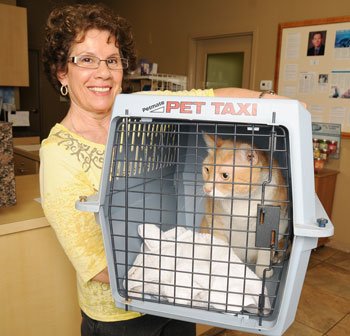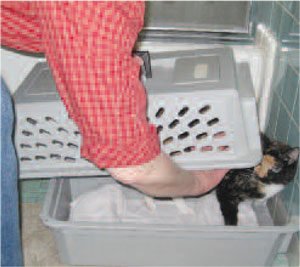Getting Your Cat to the Veterinarian

Reducing the Stress of Veterinary Visits for You and Your Cat
Providing good health care, especially preventive health care, can allow your cats to have longer, more comfortable lives. However, this cannot happen unless they see the veterinarian for needed care. Many cats dislike going to the veterinarian, and that starts with the difficulty of getting the cat into the carrier. If we can make this step easier, the entire veterinary visit is usually less stressful.
The following tips will help make veterinary visits easier for you and your cat.
Understanding your Cat’s Behavior
- Cats are most comfortable with the familiar, and need time to adjust to the unfamiliar. The visit to the veterinarian is often difficult because the carrier, car, and the veterinary hospital are usually unfamiliar. Respect your cat’s need for time to become familiar with new situations, people and places.
- Stay calm. Cats can sense our anxiety or frustrations, which may cause them to become fearful or anxious.
- Cats do not learn from punishment or force. Give rewards to encourage positive behavior. For example, if your cat is sitting calmly in or near a carrier, give a treat. Likewise, rewards can be given to help your cat become familiar with the type of handling that may be encountered at the veterinarian (e.g., handling paws, ears and mouth). A treat is what is highly desirable to your cat, which may be in the form of food, play or affection. Be persistent and reward every time.
Helping Your Cat Become Comfortable with the Carrier
 The goal is for your cat to learn to associate the carrier with positive experiences and routinely enter voluntarily.
The goal is for your cat to learn to associate the carrier with positive experiences and routinely enter voluntarily.
- Make the carrier a familiar place at home by leaving it in a room where your cat spends a lot of time.
- Place familiar soft bedding inside the carrier. Bedding or clothing with your scent can make them feel more secure.
- Place treats, catnip or toys inside the carrier to encourage the cat to enter at home. Often, you will first see that treats are removed from the carrier during the night.
- It may take days or weeks before your cat starts to trust the carrier. Remain calm, patient and reward desired behaviors.
- If you still have trouble, you may need to assess the carrier itself.
Getting an Unwilling Cat into the Carrier
 If your cat needs to go to the veterinarian right away, and is not yet accustomed to the carrier, the following may help:
If your cat needs to go to the veterinarian right away, and is not yet accustomed to the carrier, the following may help:
- Start by putting the carrier in a small room with few hiding places. Bring the cat into the room and close the door. Move slowly and calmly. Do not chase the cat to get it into the carrier. Encourage the cat with treats or toys to walk into the carrier.
- If your cat will not walk into the carrier, and your carrier has an opening on the top, gently cradle your cat and lower it into the carrier. Another option is to remove the top half of your carrier while getting the cat to go into the bottom half, and then calmly replace the top as pictured above.
- Use familiar bedding inside the carrier. Consider use of synthetic feline facial pheromone (Feliway®) analog spray in the carrier at least 30 minutes prior to transport to help calm the cat.
Coming Home – Keeping the Peace in a Multi-cat Household
Cats are very sensitive to smells, and unfamiliar smells can result in one cat no longer recognizing another. Aggressive behavior can occur when one cat senses another as a stranger. These suggestions can help avoid problems between cats following a veterinary visit:
- Leave the returning cat in the carrier for a few minutes to see how all of your cats react.
- If all cats appear calm and peaceful, let the returning cat out of the carrier.
- If you sense tension between the cats, or if previous home-comings have resulted in conflict, keep the cat in the carrier and take it to a separate room to avoid potential injury from an upset cat. Provide food, water and litter box for a minimum of 24 hours while it regains the more familiar smell of home.
- If there is still stress after this time, contact your veterinarian for more advice on slower introduction or medication to help the process.
- A synthetic feline pheromone (Feliway®) can help provide the sense of familiarity.
- For future visits:
• Use familiar bedding or clothing with your scent, as it retains the smell of home and helps with reintroduction.
• Use a synthetic feline pheromone (Feliway®).
• Bring both cats to the veterinary practice together. This can prevent future conflict as both cats will carry the scent of the clinic.
What Type of Carriers are Best?
 The best carriers are inexpensive hardsided carriers that open from the top and the front, and can also be taken apart in the middle. An easily removable top allows a cat which is fearful, anxious or in pain to stay in the bottom half of the carrier for exams. Your veterinarian can often do the exam in the bottom of a well-designed carrier. Avoid carriers that require a cat to be pulled from or dumped out for an exam.
The best carriers are inexpensive hardsided carriers that open from the top and the front, and can also be taken apart in the middle. An easily removable top allows a cat which is fearful, anxious or in pain to stay in the bottom half of the carrier for exams. Your veterinarian can often do the exam in the bottom of a well-designed carrier. Avoid carriers that require a cat to be pulled from or dumped out for an exam.
Choose carriers that are sturdy, secure and stable for the cat, as well as easy for you to carry. The Center for Pet Safety recommends that the carrier be belted into the backseat only if they have been crash tested. All others should be placed on the floor of the backseat.
Some cats like to see out, whereas others are less anxious when the carrier is covered with a blanket or towel to prevent seeing the unfamiliar.
We are here to help your cat have more relaxed veterinary visits and improved healthcare. Please contact us if you have any questions.
We wish to thank CEVA Animal Health Inc. for sponsoring this information. To access the full guidelines document, please visit www.catvets.com and www.icatcare.org.
- Behavior (12)
- Caring for your pet (266)
- cat (6)
- Community Events (19)
- dog (7)
- From Our Clients (15)
- Happy Tails (9)
- News (424)
- Press (53)
- Products (2)
- Questions (4)
- Recalls (1)
- Special Offers (5)
- Tips & Advice (231)
- Uncategorized (19)
- Veterinary Services (48)
